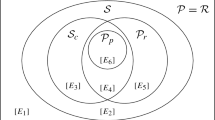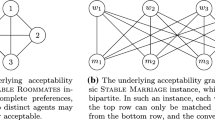Abstract
Classical roommate problems define individual rationality by conceiving remaining single as the “outside option”. This conception implicitly assumes that there are always some empty rooms to be shared. However, there are many instances when this is not the case. We introduce roommate problems with a limited number of rooms, where the “outside option” is “having no room”. In this general framework, we show that the core equals the set of Pareto optimal and stable matchings.
Similar content being viewed by others
Notes
Morrill (2010) redefines individual rationality as follows: A matching is individually rational if each agent prefers his/her current mate to his/her mates under the initial matching. Vergote (2019) keeps the classical definition of individual rationality: A matching is individually rational if each agent prefers his/her current mate to being single.
Besides the definition of individual rationality, our model differs from Morrill (2010) in two additional ways. Firstly, instead of starting with an initial allocation, we embed the outside option into the model and define a generalized matching problem with a limited number of available rooms. Secondly, we allow individuals to stay single in a room or move with his/her mate to an empty room if it exists. However, Morrill (2010) analyses roommate problems with an even number of agents where each pair of agents is endowed initially with a room. So there is no empty room in any allocations.
|A| denotes the number of the agents in A.
If \(n=|A|\) and \(jP_{i}c_{0}\) for any \(i,j\in A,\) then it is a standard roommate problem.
Note that \(o_{A^{\prime },\mu }+o_{A\backslash A^{\prime },\mu }=o_{A,\mu }\) if and only if \(\underset{i\in A^{\prime }}{\cup }\left\{ \mu (i)\right\} =A^{\prime }\cup \{c_{0}\}\) and \(\underset{i\in A\backslash A^{\prime }}{ \cup }\left\{ \mu (i)\right\} =(A\backslash A^{\prime })\cup \{c_{0}\}.\)
The last condition differs from “exchange proofness” proposed by Alcalde (1995), asking the permission of their current mates for an exchange.
As Vergote (2019) defines the set of directly stable matchings as the set of matchings that are not directly blocked by any coalitions, the set of directly stable matchings and the direct core are equivalent. Although our core definition is identical to Vergote’s (2019) direct core; according to our definition of blocking, the set of stable matchings is a superset of Vergote’s (2019) set of directly stable matchings and the direct core.
References
Alcalde J (1995) Exchange-proofness or divorce-proofness? Stab One-sided Matching Markets, Econ Design 1:275–287
Can B, Klaus B (2013) Consistency and population sensitivity properties in marriage and roommate markets. Soc Choice Welfare 41:835–862
Chung KS (2000) On the existence of stable roommate matchings. Games Econom Behav 33:206–230
Gale D, Shapley L (1962) College admissions and the stability of marriage. Am Math Monthly 69:9–15
Klaus B (2011) Competition and resource sensitivity in marriage and roommate markets. Games Econom Behav 72:172–186
Klaus B (2017) Consistency and its converse for roommate markets. Games Econom Behav 104:43–58
Morrill T (2010) The roommates problem revisited. J Econ Theory 145:1739–1756
Roth AE, Sotomayor MAO (1990) Two-sided matching: a study in game theoretic modelling and analysis. Cambridge University Press, Cambridge
Tan JJM (1991) A necessary and sufficient condition for the existence of a complete stable matching. J Algorithms 12:154–178
Vergote W (2019) Revisiting stability in one-to-one matching problems. Econ Theory Bull 7:59–75
Author information
Authors and Affiliations
Corresponding author
Additional information
Publisher's Note
Springer Nature remains neutral with regard to jurisdictional claims in published maps and institutional affiliations.
Rights and permissions
About this article
Cite this article
Nizamogullari, D., Özkal-Sanver, İ. A note on roommate problems with a limited number of rooms. Rev Econ Design 26, 553–560 (2022). https://doi.org/10.1007/s10058-022-00297-4
Received:
Accepted:
Published:
Issue Date:
DOI: https://doi.org/10.1007/s10058-022-00297-4




